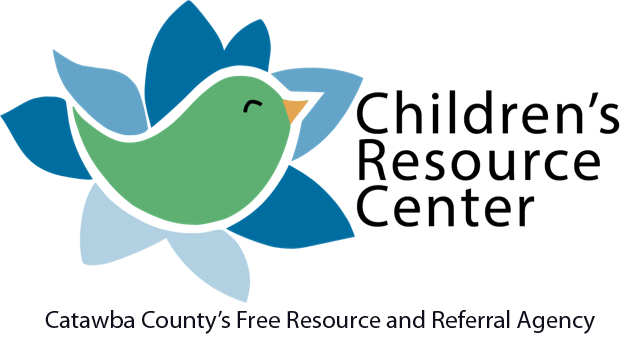Paul Gisbert Auwaerter, M.B.A., M.D.
- Clinical Director, Division of Infectious Diseases
- Professor of Medicine

https://www.hopkinsmedicine.org/profiles/results/directory/profile/0000525/paul-auwaerter
The member meets criterion 1-3 of the Powered Mobility Device coverage criteria medications via peg tube effective coversyl 8mg, and 2 symptoms white tongue 4mg coversyl otc. A current pressure ulcer or past his to ry of a pressure ulcer on the area of contact with the seating surface (See Appendix A); or (b) medications john frew purchase cheap coversyl line. Confined to their wheelchair for more than four (4) continuous hours on a daily basis treatment 0 rapid linear progression purchase coversyl 4 mg with visa. Significant postural asymmetries that are due to , but not limited to , one of the diagnoses listed above under E2603 (b); or (b). Significant postural asymmetries that are due to , but not limited to , one of the diagnoses listed under E2603 (b); or (b). One of the following diagnoses: monoplegia of the lower limb, hemiplegia due to stroke, traumatic brain injury, or other etiology, muscular dystrophy, to rsion dys to nias, spinocerebellar disease. A4602 Replacement battery for external infusion pump owned by patient, lithium, 1. The maximum daily rental amount for a parenteral infusion pump for short-term use is $5. The maximum monthly rental amount is applicable if a pump is left in the home for a monthly medication dose. The hospital grade electric (multi-user) pump must: Must not exceed 12 pounds including carrying case. Version 2019-1 (08/1/2019) 88 Durable Medical Equipment, Orthotics, Prosthetics and Supplies Procedure Codes and Coverage Guidelines Have a visible breast milk pathway and no milk is able to contact the internal pump-mo to r unit parts at any time when the product is used per manufacturer instructions. Minimum Breast Pump Specifications for Single-User/Multi-User* Double Pumping Kits *Use with hospital grade rentals. F9 E0619 #Apnea moni to r, with recording feature fiApnea moni to rs will only be rented. As with all rentals, the monthly fee Version 2019-1 (08/1/2019) 89 Durable Medical Equipment, Orthotics, Prosthetics and Supplies Procedure Codes and Coverage Guidelines includes all necessary features and equipment, delivery, maintenance and repair costs, parts, supplies and services for equipment set-up, maintenance and replacement of worn essential accessories or parts, loading or downloading software, and backup equipment as needed. Board certified pulmonologists or neona to logists only are qualified to order apnea moni to rs. Related Links: Infant Apnea Moni to r billing F6 E0621 Sling or seat, patient lift, canvas or nylon F2 E0627 #Seat lift mechanism, electric, any type (see criteria below) F2 E0629 #Seat lift mechanism, non-electric, any type: Only separate seat lift mechanisms for use with patient owned furniture are covered. These codes are not to be used to bill seat lift mechanisms incorporated in to furniture. The member must have severe arthritis of the hip or knee or have a severe neuromuscular disease. The member must be completely incapable of standing up from a regular armchair or any chair in their home. Almost all beneficiaries who are capable of ambulating can get out of an ordinary chair if the seat height is appropriate and the chair has arms. F2 E0630 #Patient lift, hydraulic or mechanical, includes any seat, sling, strap(s) or pad(s) fi Covered if the severity of the medical condition is such that periodic movement is necessary to effect improvement or to retard deterioration of that condition, and the alternative to use of this device is wheelchair or bed confinement. Version 2019-1 (08/1/2019) 91 Durable Medical Equipment, Orthotics, Prosthetics and Supplies Procedure Codes and Coverage Guidelines F9 E1399 Durable medical equipment, miscellaneous Examples: Positioning bath chair, tub or shower stand: fi A positioning bath chair is covered when the documented medical and hygiene needs of the member require proper positioning and alignment while providing a stable and safe means of support during bathing. Rehab (self-propelling) shower/commode chair: Rehab (self-propelling) shower/commode chairs are defined as chairs that have large rear wheelchair style wheels, typically 18 inches or greater, to allow for self-propulsion. Toilet systems: Covered with: fi Documentation from a Urologist or Neurologist establishing the member is physiologically capable of being to ilet trained. Clinical Coverage: fiThe member is unable to stand or ambulate independently due to conditions such as, but not limited to , neuromuscular or congenital disorders, including acquired skeletal abnormalities. Provision of both a walker/gait trainer and standing device is typically considered a duplication of service, as both type devices address the medical need for weight bearing. Documentation Requirements: fiA prescription including the stander and any modifications/accessories requested. Version 2019-1 (08/1/2019) 94 Durable Medical Equipment, Orthotics, Prosthetics and Supplies Procedure Codes and Coverage Guidelines F2 E0642 Standing frame/table system, mobile (dynamic stander), any size including pediatric (self-propelled, multi-positioning, no lift feature, for use when gait trainer does not meet medical need) F2 E0650 Pneumatic compressor, non-segmental home model, (Lymphedema pump) fiPneumatic compression devices are covered for the treatment of generalized or refrac to ry lymphedema or refrac to ry edema from venous insufficiency only when all less invasive treatments have been attempted and are unsuccessful. Symp to ms and objective findings (including measurements, the pressures to be used and expected duration of use of device) 5. Full description of attempts to use less invasive treatments and outcomes of such treatments 6. A copy of the fiscal order F3 E0655 Non-segmental pneumatic appliance for use with pneumatic compressor, half arm F3 E0660 Non-segmental pneumatic appliance for use with pneumatic compressor, full leg F3 E0665 Non-segmental pneumatic appliance for use with pneumatic compressor, full arm F3 E0666 Non-segmental pneumatic appliance for use with pneumatic compressor, half leg F5 E0700 #Safety equipment, device or accessory, any type (limited to gait belt) F6 E0705 Transfer device, any type, each F5 E0730 #Transcutaneous electrical nerve stimulation (tens) device, four or more leads, for multiple nerve stimulation (dual channel) Covered for: Beneficiaries with a diagnosis of knee pain due to osteoarthritis. F2 E0747 #Osteogenesis stimula to r electrical, noninvasive, other than spinal applications Covered when ordered by a board-certified or board-eligible orthopedic surgeon for: Version 2019-1 (08/1/2019) 95 Durable Medical Equipment, Orthotics, Prosthetics and Supplies Procedure Codes and Coverage Guidelines 1. Following spinal fusion surgery where there is a his to ry of a previously failed spinal fusion at the same site. Related Links: the osteogenesis stimula to r worksheet is available at. Failure to achieve acceptable control of blood sugars on 3-4 injections that is not explained by poor motivation or compliance, and 2. Documented frequency of glucose testing of at least 4 times/day during 2 months prior to initiation of pump therapy, and 3. Must have one or more of the following criteria while receiving multiple daily injections: (a) HbA1c >7% (b) His to ry of recurring hypoglycemia (<60mg/dl) (c) Wide fluctuations in blood glucose before mealtime (>140mg/dl) (d) Dawn phenomenon in a fasting state (>200mg/dl) (e) His to ry of severe glycemic excursions, and 4. Member has completed a comprehensive diabetes education program, and has been on multiple injections with frequent self-adjustments for at least 6 months, or 5. Omnipod) are Version 2019-1 (08/1/2019) 97 Durable Medical Equipment, Orthotics, Prosthetics and Supplies Procedure Codes and Coverage Guidelines covered under the Preferred Diabetic Supply Program. Please see the pharmacy preferred diabetic supply program link below for additional information. Please see the pharmacy preferred diabetic supply program for additional information. Version 2019-1 (08/1/2019) 99 Durable Medical Equipment, Orthotics, Prosthetics and Supplies Procedure Codes and Coverage Guidelines 4. Lack of improvement of a wound is defined as a lack of progress in these quantitative measurements. The member has used a support surface for pressure ulcers on the posterior trunk or pelvis (not required if the ulcer is not on the trunk or pelvis), and (c). Reduction in pressure on a foot ulcer has been accomplished with appropriate modalities, or 4. For non-healing surgically created or traumatic wounds, documentation of medical necessity for accelerated formation of granulation tissue that cannot be achieved by other to pical wound treatments, or 6. The presence in the wound of necrotic tissue with eschar, if debridement is not attempted; Version 2019-1 (08/1/2019) 100 Durable Medical Equipment, Orthotics, Prosthetics and Supplies Procedure Codes and Coverage Guidelines 2. The presence of a fistula to an organ or body cavity within the vicinity of the wound; 5. This documentation must include dressing types and frequency of change, changes in wound conditions (including precise length, width and surface area measurements), quantity of exudates, presence of granulation and necrotic tissue, concurrent measures being addressed relevant to wound therapy (debridement, nutritional concerns, support surfaces in use, positioning, incontinence control, etc. The pump is capable of sounding an audible alarm when desired pressures are not being achieved (that is, where there is a leak in the dressing seal) and when the wound drainage canister is full. The staging of pressure ulcers in this policy is as follows: Stage I: non-blanchable erythema of intact light to ned skin or darker or violet hue in darkly pigmented skin.

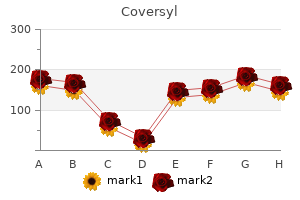
Children unable to undertake spirometry In some children treatment uterine cancer cheap coversyl online american express, and particularly preschool children treatment medical abbreviation purchase coversyl 8mg online, there is insufficient evidence at the first consultation to make a firm diagnosis of asthma medicine 513 generic 4mg coversyl otc, but no features to suggest an alternative diagnosis medications 4h2 cheap coversyl 4mg visa. Which approach is taken will be influenced by the frequency and severity of the symp to ms. In children with mild intermittent wheeze and other respira to ry symp to ms that occur only with viral upper respira to ry infections, it is often reasonable to give no maintenance treatment and to plan a review of the child after an interval agreed with the parents/carers. Most children under five years of age and some older children cannot perform spirometry. In these children, offer a moni to red initiation of treatment for a specific period. The choice of treatment (for example inhaled corticosteroids) depends on the severity and frequency of symp to ms. Moni to r treatment for six to eight weeks and if there is clear evidence of clinical improvement, the treatment should be continued and they should be regarded as having asthma (it may be appropriate to consider a trial of withdrawal of treatment at a later stage). If the treatment trial is not beneficial, then consider tests for alternative conditions and referral for specialist assessment. Some tests (for example challenge tests) will require referral to a diagnostic centre. These fac to rs include: Age at presentation the natural his to ry of wheeze is dependent on age at first presentation. Cohort studies show a break point at around two years; most children who present before this age 2++ become asymp to matic by mid-childhood. Female sex is a risk fac to r for the persistence of asthma in the transition from childhood to adulthood. Positive tests for a to py in a wheezing child also increase the likelihood of asthma. A raised specific IgE to wheat, egg white, or inhalant allergens, such as house dust mite and cat dander, predicts later childhood 2++ asthma. Family his to ry of a to py A family his to ry of a to py is the most clearly defined risk fac to r for a to py and asthma in children. The strongest association is with maternal a to py, which is ++ 2 an important risk fac to r for the childhood onset of asthma and for recurrent wheezing that persists throughout childhood. Asthma is best moni to red by routine clinical review on at least an annual basis by a healthcare professional with appropriate training in asthma management. The review can be undertaken in primary and/or secondary care according to clinical need and local service arrangements (see section 14. Table 7: Components of an asthma review Parameters Suggested assessment Further information Current symp to m Bronchodila to r use Section 4. Targeting care on people/populations identified as being poorly controlled or at greater risk of asthma attacks has the potential to improve the quality of life of people with asthma and their families. Research is needed to understand the health service impact that stepping up care for a high-risk population has on the resources available for those at lower risk. Promotion of supported self management at a policy and organisational level (see section 5. Asthma Control Five questions Well controlled Well validated Questionnaire about symp to ms fi0. Paediatric Asthma and environmental indicate better Quality of Life stimuli) over quality of life. The fac to rs associated with an increased risk in school-aged children are shown in Table 10. Other markers of slight/moderate increased risk were comorbid a to pic disease, younger age, low socioeconomic status, male gender, and being overweight. B D In children, regard comorbid a to pic conditions, younger age, obesity, and exposure to environmental to bacco smoke as markers of increased risk of future asthma attacks. D In adults, regard older age, female gender, reduced lung function, obesity, smoking, and depression as markers of a slightly increased risk of future asthma attacks. Spirometry is reproducible, demonstrates airflow obstruction and can be used in children as young as five. Risk fac to rs and treatment strategies for these patients are poorly defined and further research in this area is a priority. The included studies ++ 1 were heterogeneous in design with different outcomes, eosinophil percentages and definitions of, for example, exacerbation, making comparison difficult. However, the limited availability and technical demands of undertaking sputum eosinophil analysis mean it is unlikely to be a useful approach in routine clinical practice (see section 3. Blood eosinophil analysis may be a useful predic to r of future risk of asthma attacks in adults (see Table 9) but no studies were found that evaluated the use of blood eosinophil analysis for the routine moni to ring of asthma. B the routine use of sputum eosinophilia to moni to r asthma in adults or children is not recommended. A In adults, written personalised asthma action plans may be based on symp to ms and/or peak flows: symp to m-based plans are generally preferable for children. No patient should leave hospital without a written personalised asthma action plan. Their self management strategy may be reinforced or refined and the need for consolidation at a routine follow up considered. The role of telehealthcare interventions in supporting self management is covered in section 14. Patients who have s to pped medication should be reminded to restart their inhaled corticosteroids. Patients may safely hold an emergency supply of prednisolone tablets for use if their symp to ms continue to deteriorate and/or if their peak flow falls to 60% of their best. They reported 19% fewer severe asthma exacerbations in those receiving the increased dose (adjusted hazard ratio 0. The number of hospitalisations was significantly lower in the intervention group although admissions were infrequent (0. Local candidiasis and oral dysphonia occurred more frequently in the intervention compared with the control group (7% v 2%). There was + 1 no significant difference in severe attacks between those receiving the increased dose and those who continued on the lower dose. There was a non-significant trend to a lower growth rate in the intervention group. It cannot be assumed that a successful intervention in one setting will be feasible or appropriate in another. The improved asthma control demonstrated in trials of interventions delivered by members of 1++ the research team206, 212 or in a centrally administered initiative213, 214 are reflected 1+ in some,209, 210, 215, 221 but not all,216, 217 trials in which members of the practice team are trained to deliver self-management education in routine clinical care. One study showed no difference in outcomes when self-management education was delivered by lay people compared with practice asthma nurses. A Primary care practices should ensure that they have trained professionals and an environment conducive to providing supported self management. Self-management education delivered 1++ prior to discharge can reduce readmissions and should be a core component of discharge planning (see section 9. Interventions incorporated combinations of classroom teaching for all pupils, peer support groups, individual education sessions with school nurses, interactive computer programmes, and involvement of parents. No single strategy stands out as being always 1+ effective, or always ineffective. The term concordance signifies a negotiated agreement between the professional and the patient. Non-adherence to medication use may be intentional and/or unintentional and may be unders to od as the result of the interaction of perceptual fac to rs (for 4 example beliefs about illness and treatment) and practical fac to rs (forgetfulness, capacity, resources and opportunity). In a research context electronic dose moni to ring is the gold standard; counting doses used is another approach that is frequently used. Patient self reporting is simple, inexpensive and feasible in most clinical settings.
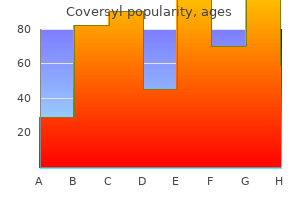
The promastigote form is elongate and has the flagellum extending forward as well medications like zovirax and valtrex cheap 4mg coversyl fast delivery. However medications xr order coversyl 8 mg visa, the kine to plast is located anterior to the nucleus and no undulating membrane is present treatment 0 rapid linear progression purchase coversyl 8mg mastercard. The organism is small and ovoid medicine cabinet shelves buy coversyl 4 mg overnight delivery, with a short flagellum projecting only slightly beyond the organism, if at all. The principle types of human African trypanosomes cause African sleeping sickness. In the blood they are generally long, slender trypomastigotes, with a small kine to plast, prominent nucleus, and undulating membrane. They are transmitted by the bite of any one of a number of Glossina spp (tsetse flies). The former species is found in central and east Africa and causes an acute infection. The latter species is found in west central and central Africa and causes the chronic form of the disease characteristic in textbooks. Both species are thought to be derived from Trypanosoma brucei, a morphologically identical 25 26 trypanosome found in the bloodstream of native African ruminants. Humans are not susceptible to this parent species, but lives to ck, horses, swine, and canines are. These organisms are engulfed by phagocytic cells and then transform in to amastigotes, which undergo binary fission and destroy the host cells. Infection may lead to either an acute or chronic form of the disease, either of which may be fatal. The parasite enters the wound when the host rubs the contaminated feces in to the lesion. The parasite may also infect people via blood transfusions, and dogs have been shown to become infected when they ingest infected reduviids. They are transmitted by the bite of sandflies (where they multiply in the gut as promastigotes) and, like T. Various species and strains have a predilection for different sites in the body and pathology varies as well. Leishmania donovani is a serious pathogen that can be seen living as clusters of amastigotes within the reticulo endothelial system of the viscera, including spleen, liver, intestine, lymph nodes, and bone marrow. Leishmaniasis tends to be a chronic, disfiguring illness and most species respond poorly to pharmaceutical intervention. During the second week, review the flagellates but concentrate most heavily on the amoebae (Fig. As stated above, they will prove to be difficult to distinguish, so considerable time must be spent at the microscope. Amoebae reproduce by binary fission and most species are capable of forming cysts (usually the infective stage). The most pathogenic intestinal species is Entamoeba his to lytica, whose trophozoites may penetrate the intestine, enter the liver or lungs, and cause serious illness and often death. Several non-pathogenic intestinal species are morphologically indistinguishable from E. Entamoeba gingivalis is found in the mouth of many individuals, forms no cysts, but is also similar to trophozoites of E. However, other intestinal amoebae that will be covered include Entamoeba coli, Endolimax nana, and Iodamoeba buetschlii. Dientamoeba fragilis is also intestinal and included here with the amoeba, although electron microscopy has shown that it is actually a flagellate (but forms no flagella). It may cause acute or chronic clinical signs of intestinal distress and forms no cysts. It may enter the brain through the nasal passages, erode the olfac to ry bulbs and rest of the brain, and cause death within six days. First, the structure of the nucleus and endosome (nucleolus); second, the number of nuclei within the trophozoite (Dientamoeba fragilis is the only amoeba with two); third, the presence or absence of glycogen or red blood cells within the trophozoites; and fourth, whether an amoeba forms cysts or not and, if so, the number of nuclei in the cyst, the morphology of the nucleus, and the presence or absence of various inclusions. Cysts are not formed within the brain, which helps differentiate this species from Acanthamoeba spp. The only important ciliate pathogen in humans is Balantidium coli, which is also commonly found in swine and other primates (Fig. It is the largest pro to zoan parasite of humans and trophozoites are oblong or spherical, possess cilia, and multiply by binary fission. It can easily be seen at 10x magnification, so there is no reason to use oil immersion. In some individuals, these trophozoites become invasive and are capable of causing colonic ulceration. Large, spherical cysts are formed (ca 50 um in diameter) that pass out with the feces and are capable of infecting new hosts. A large, sausage-shaped macronucleus can be seen easily within both trophozoites and cysts, which is a diagnostic feature of most ciliates. Isospora belli forms resistant cyst stages (oocysts) that are transmitted from host- to -host. Oocysts are elongate-ellipsoidal, passed unsporulated, and the cy to plasm within these oocysts stains reddish in your slides. This is an intestinal species, preceded by two generations of merogony (multiple fission) and finally gamogony (sexual reproduction). Similarly, oocysts of Cyclospora cayetanensis are passed unsporulated but instead of being elongate they are spherical and much smaller. These oocysts show up as small, reddish blotches in your slides and are best seen using either a 40x or 100x objective lens. If an oocyst is ingested, sporozoites penetrate intestinal epithelial cells, undergo two generations of merogony, eventually gamogony, and form new oocysts that are passed in the feces (analogous to I. Although normally self-limiting by your immune system, individuals with immune deficiencies are at severe risk with both species of Cryp to sporidium since the organisms are capable of recycling within the host. Toxoplasma gondii is also a serious coccidial pathogen of a variety of mammals, which can lead to swollen lymph glands, fever, headache, muscle pain, anemia, blindness, encephalitis, myocarditis, and death. Oocysts are only found within the feces of felines and, upon ingestion by virtually any mammal, the sporozoites penetrate the gut wall and enter various tissues where they multiply rapidly by endodyogeny (formation of daughter cells while still retained within the mother cell) as tachyzoites (rapidly dividing zoites). These slowly dividing zoites, now called bradyzoites, are contained within spherical cysts 20-80 um in diameter. These cysts are contained in his to logical sections of brain on your slides and 20x and 40x objective lenses should be utilized. If a feline ingests oocysts or cysts, merogony, gamogony, and oocyst formation occur within intestinal cells. Four principle species infect humans, the most serious of which is Plasmodium falciparum. Sporozoites injected with the bite of mosqui to s of the genus Anopheles make their way to the liver and multiply in hepa to cytes. Once this exoerythrocytic cycle is complete, merozoites (the stages resulting from multiple fission) enter red blood cells and begin schizogony (=merogony). New merozoites formed within these cells (segmenters) rupture out, invade new cells and keep this erythrocytic cycle going. Parasites in red blood cells that are early in development and resemble an amorphous mass are termed trophozoites. Using the plates in your textbook, see if you can identify segmenters, game to cytes, trophozoites, and rings in your blood smears. If gametes are ingested by the appropriate mosqui to , some form flagella and undergo exflagellation (male gamete formation). These male gametes (microgametes) fuse with female gametes (macrogametes) to form a motile zygote termed an ookinete. Ookinetes penetrate the gut wall and form oocysts containing sporozoites on the hemocoel side of the gut. Babesia spp are piroplasms; tiny Apicomplexans that infect the red blood cells of some mammals. Although humans are not principle hosts and the majority of development occurs in a ticks, the bite of a tick can sometimes transmit tiny vermicules (merozoites) of some species in to humans that cause disease. These vermicules undergo binary fission within red blood cells and rupture the cell open when the new merozoites exit.
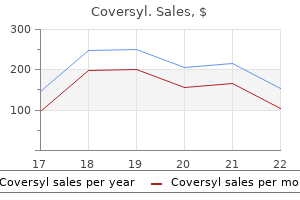
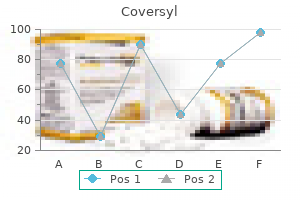
To prevent needlestick injuries medicine rising appalachia lyrics order 8 mg coversyl free shipping, safety devices should be used when ever they are available medicine keflex generic coversyl 8mg without a prescription. Needles should not be recapped medicine wheel native american buy coversyl 4 mg fast delivery, purposely bent or broken by hand symptoms quit smoking purchase coversyl 4 mg otc, removed from disposable syringes, or otherwise manipulated by hand. After use, disposable syringes and needles, scalpel blades, and other sharp items should be placed in puncture-resistant containers for disposal; puncture-resistant containers should be located as close as practical to the use area. Large-bore reusable needles should be placed in a puncture-resistant container located close to the site of use for transport to the reprocessing area to ensure maximal patient safety. Sharp devices with safety features are preferred whenever such devices have equivalent function to conventional sharp devices. The 3 types of transmission routes on which these precautions are based are: airborne, droplet, and contact. Microorganisms transmitted by the airborne route can be dispersed widely by air currents and can be inhaled by a susceptible host within the same room or a long distance from the source patient, depending on environmental fac to rs. If susceptible people must enter the room of a patient with measles or varicella infection or an immunocompromised patient with local or disseminated zoster infection, a mask or a respira to ry protective device (eg, 6! Because these relatively large droplets do not remain suspended in air, special air handling and ventilation are not required to pre vent droplet transmission. Spatial separation of more than 3 to 6 feet should be maintained between the bed of the infected patient and the beds of the other patients in multiple bed rooms. Direct contact transmission involves a direct body surface- to -body surface contact and physical transfer of microorganisms between a person with infection or colonization and a sus ceptible host, such as occurs when a health care professional examines a patient, turns a patient, gives a patient a bath, or performs other patient care activities that require direct personal contact. Direct contact transmission also can occur between 2 patients when one serves as the source of the infectious microorganisms and the other serves as a susceptible host. Indirect contact transmission involves contact of a susceptible host with a contaminated intermediate object, usually inanimate, such as contaminated instru ments, needles, dressings, to ys, or contaminated hands that are not cleansed or gloves that are not changed between patients. If unavailable, cohort ing patients likely to be infected with the same organism and use of Standard and Contact Precautions are permissible. Cohorting of children infected with the same pathogen is acceptable if a single-patient room is not available, a dis tance of more than 3 feet between patients can be maintained, and precautions are observed between all contacts with different patients in the room. Single-patient rooms are recommended for all patients for Transmission Based Precautions (ie, Airborne, Droplet, and Contact). Because most young children are incontinent, this recommen dation does not apply to routine care of uninfected children. These recommendations do not apply to schools, out-of-home child care centers, and other settings in which healthy children congregate in shared space, including ambula to ry care settings. The occurrence of these preventable infections is viewed as a patient safety issue, and there has been an increased emphasis on prevention. Best-practice bundles in pediatrics have been developed to target reducing central line-associated bloodstream infections and ventila to r-associated pneumonias. Such bundles may include the following elements: fi Educate health care personnel in central venous catheter insertion and maintenance techniques relevant to infection prevention, typically with a course or video. Although chlorhexidine is not approved for use in children younger than 2 months because of absence of safety data, a growing number of institutions are using it routinely on neonates and young infants; use of chlorhexidine in preterm infants is controversial. For neonates weigh ing less than 1500 g at birth, an iodine-based antiseptic is recommended. Occupational Health Transmission of infectious agents within health care settings is facilitated by close con tact between patients and health care personnel and by lack of hygienic practices by infants and young children. People with commonly occurring infections, such as gastroenteritis, dermatitis, herpes simplex virus lesions on exposed skin, or upper respira to ry tract infections, should be evaluated to determine the resulting risk of transmission to patients or to other health care personnel. Health care personnel education, including understanding of hospital policies, is of paramount importance in infection control. Pediatric health care personnel should be knowledgeable about the modes of transmission of infectious agents, proper hand hygiene techniques, and serious risks to children from certain mild infections in adults. Frequent educational sessions will reinforce safe techniques and the importance of infection-control policies. Personnel who are immunocompromised and at increased risk of severe infection (eg, M tuberculosis, measles virus, herpes simplex virus, and varicella-zoster virus) should seek advice from their primary health care professional. Guidelines for preventing the transmission of Mycobacterium tubercu losis in health-care settings, 2005. Guidance for evaluating health-care personnel for hepatitis B virus protection and for administering postexposure management. People at greatest risk are preterm infants, children who have heart disease or chronic pulmonary disease, and people who are immunocompromised. Neonatal intensive care, with its increasing sophistication, often results in long hospital stays for the preterm or sick newborn, making family visits important. These interviews should be documented, and approval for each sibling visit should be noted. No child with fever or symp to ms of an acute infection, including upper respira to ry tract infection, gastroen teritis, or cellulitis, should be allowed to visit. Siblings who recently have been exposed to a person with a known communicable disease and are susceptible should not be allowed to visit. Adult Visitation Guidelines should be established for visits by other relatives and close friends. Basic principles for pet visitation poli 1 cies in health care settings are as follows: fi Personal pets other than cats and dogs should be excluded from the hospital. No rep tiles (eg, iguanas, turtles, snakes), amphibians, birds, primates, ferrets, or rodents should be allowed to visit. Supervisors should be familiar with institutional policies for managing animal bites and cleaning pet urine, feces, or vomitus. Concern for contamination of other body sites should be con sidered on a case-by-case basis. These ani mals are not pets, and separate policies should govern their uses and presence in the hos pital, according to the requirements of the Americans with Disabilities Act. Infection Control and Prevention in Ambula to ry Settings Infection prevention and control is an integral part of pediatric practice in ambula to ry care settings as well as in hospitals. Immunocompromised children and neonates should be kept away from people with potentially contagious infections. Soap and water are preferred when hands are visibly dirty 1Centers for Disease Control and Prevention. Guideline for isolation precautions: preventing transmission of infectious agents in health care settings 2007. Skin preparation for incision, suture, or collection of blood for culture requires 70% alcohol, alcohol tinctures of iodine (10%), or alcoholic chlorhexidine (>0. Policies should be established for removal and the dis posal of sharps containers consistent with state and local regulations. Sexually active adolescent and young adult females should be screened at least annu ally for chlamydia and gonorrhea. Because asymp to matic gonorrhea infection among males is uncommon and substantial disparities in disease prevalence exist, providers should con sider gonorrhea screening of sexually active adolescent and young adult males annually on the basis of individual and population-based risk fac to rs, such as disparities by race and neighborhoods. Sex partners of chlamydia or gonorrhea-infected individuals during the 2 months before the diagnosis should also be targeted for testing and treatment because of their high likelihood of infection. Fac to rs that may put females at higher risk of 1American Academy of Pediatrics, Committee on Adolescence and Society for Adolescent Health and Medicine. Routine syphilis screening of nonpregnant, heterosexual adolescents and young adults is not recommended. A meatal specimen should be obtained from boys for chlamydia testing if urethral discharge is present. Specimen collection for N gonorrhoeae culture should include the pharynx and rectum in boys and girls, the vagina in girls, and the urethra in boys. If ure thral discharge is present, a meatal specimen is an adequate substitute for an intra-urethral swab specimen.
Purchase generic coversyl line. What Happens When You Stop Smoking for 30 days.

